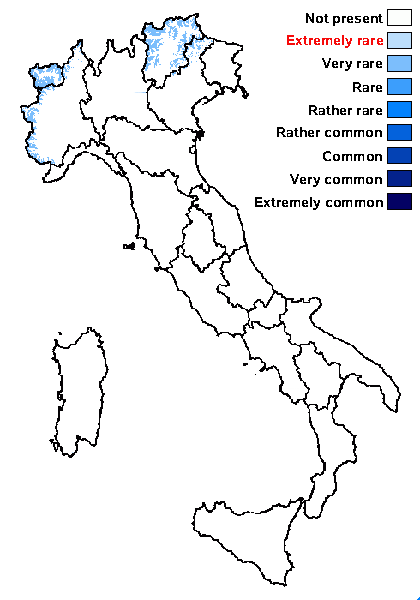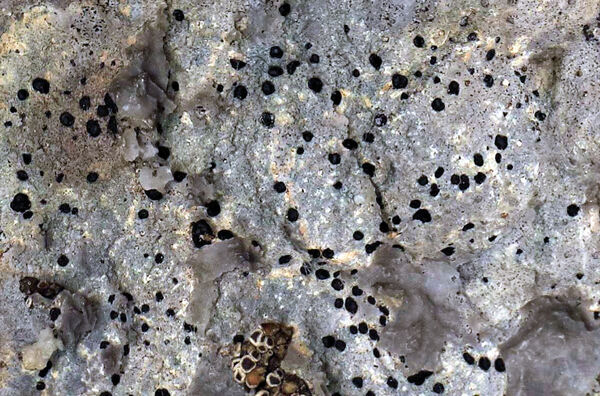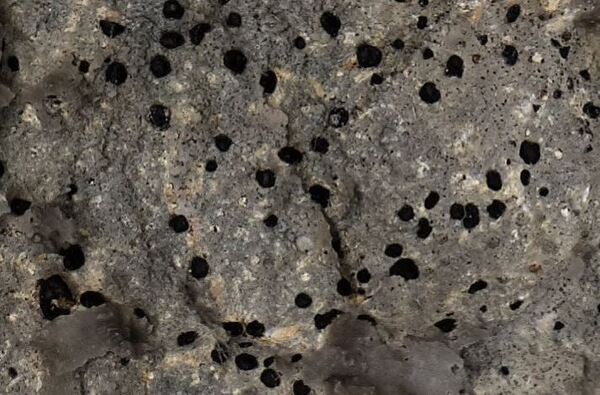Melanolecia transitoria (Arnold) Hertel
in Poelt & Vezda, Bibl. Lichenol., 16: 365, 1981. Basionym: Lecidea transitoria Arnold - Flora, 53: 123, 1870.
Synonyms: Lecidea henricii Zahlbr.; Lecidea subcoerulescens Arnold; Tremolecia transitoria (Arnold) Hertel
Distribution: N - Ven (Hertel & Schuhwerk 2010), TAA (Hertel & Schuhwerk 2010, Nascimbene & al. 2022), Piem, VA (TO 2250).
Description: Thallus crustose, fully endosubstratic, poorly evident, bluish grey to pale blue-green, the hyphae reacting K/I+ blue. Apothecia at first immersed in pits of the rock, then subsessile, 0.2-0.7(-1) mm across, glossy black, epruinose, with a flat to weakly convex disc and a thin but evident, more or less persistent proper margin. Proper exciple thick, carbonized, black throughout; epithecium blue-green, grey-green or green-brown, c. 15 μm high, K+ olivaceous green, N+ red; hymenium colourless to pale green or pale olive-brown, 40-70 μm high; paraphyses coherent, richly anastomosing, 1.7-2 µm thick at mid-level, the apical cell up to 3.5 µm wide; hypothecium brown-black, slightly paler than exciple, K+ red-brown. Asci 8-spored, narrowly clavate, thick-walled, with a K/I+ pale blue tholus and a strongly amyloid, thin apical cushion, surrounded by a I+ blue outer layer, Lecidea-type. Ascospores 1-celled, hyaline, broadly ellipsoid, (7.5-)9-13(-14) x (4-)5-7(-7.5) μm, halonate at least when young. Pycnidia black, globose, immersed. Conidia bacilliform, 3.5-8 µm long. Photobiont chlorococcoid. Spot tests: thallus K-, C-, KC-, P-, UV-. Chemistry: thallus without lichen substances.Note: a circumpolar, arctic-alpine lichen found on inclined to rain-sheltered surfaces of calcareous rocks above treeline; probably restricted to the Alps, where it reaches the nival belt.
Growth form: Crustose endolithic
Substrata: rocks
Photobiont: green algae other than Trentepohlia
Reproductive strategy: mainly sexual
Commonnes-rarity: (info)
Alpine belt: very rare
Subalpine belt: absent
Oromediterranean belt: absent
Montane belt: absent
Submediterranean belt: absent
Padanian area: absent
Humid submediterranean belt: absent
Humid mediterranean belt: absent
Dry mediterranean belt: absent

Predictive model
Herbarium samples
Growth form: Crustose endolithic
Substrata: rocks
Photobiont: green algae other than Trentepohlia
Reproductive strategy: mainly sexual
Commonnes-rarity: (info)
Alpine belt: very rare
Subalpine belt: absent
Oromediterranean belt: absent
Montane belt: absent
Submediterranean belt: absent
Padanian area: absent
Humid submediterranean belt: absent
Humid mediterranean belt: absent
Dry mediterranean belt: absent

Predictive model
| Herbarium samples |
 INDEX FUNGORUM
INDEX FUNGORUM
 GBIF
GBIF
 DOLICHENS
DOLICHENS




